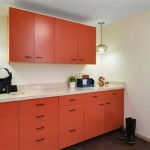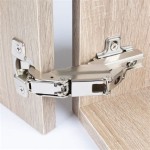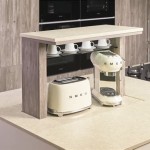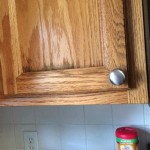How To Clean Old White Kitchen Cabinets
White kitchen cabinets offer a timeless aesthetic, brightening the space and creating a clean, airy feel. However, their pristine appearance is easily compromised by the accumulation of grease, grime, dust, and everyday spills. Older cabinets, particularly those with painted or lacquered finishes, require special care during cleaning to avoid damage. This article will detail effective and safe methods for cleaning old white kitchen cabinets, ensuring their longevity and maintaining their brightness.
Before embarking on any cleaning process, it's crucial to identify the type of finish on the cabinets. Painted, lacquered, and laminate cabinets each respond differently to cleaning solutions. Testing a cleaning method on an inconspicuous area, such as inside a cabinet door, will reveal how the finish reacts and prevent widespread damage. Gather the necessary supplies before starting the cleaning process to promote efficiency.
Identifying Cabinet Finish and Gathering Supplies
Determining the cabinet finish is the first critical step. Painted cabinets often have a slightly textured surface, while lacquered cabinets have a smooth, glossy finish. Laminate cabinets, typically found in more modern kitchens, are easily identifiable by their smooth, often uniform, surface and visible edges. Older laminate cabinets might show signs of peeling or bubbling, requiring gentle handling.
Once the finish is identified, gather the appropriate cleaning supplies. A gentle all-purpose cleaner, dish soap, warm water, soft cloths (microfiber is ideal), a soft-bristled brush (an old toothbrush works well for crevices), and a spray bottle are essential. For grease buildup, consider a degreasing cleaner specifically formulated for kitchen surfaces. Baking soda, vinegar, and lemon juice can also be used as natural cleaning agents, but they should be tested carefully due to their potential to affect certain finishes. Protective gear, such as gloves, is recommended to prevent skin irritation from cleaning solutions.
Avoid using abrasive cleaners, scouring pads, or steel wool, as these can scratch and dull the finish of older cabinets. Similarly, harsh chemicals like bleach or ammonia can damage or discolor painted surfaces. Always dilute cleaning solutions according to the manufacturer's instructions and avoid prolonged contact with the cabinet surface.
Gentle Cleaning Methods for Light Soil
For cabinets with light dust and everyday grime, a gentle cleaning solution is often sufficient. Mix a small amount of mild dish soap with warm water in a spray bottle. Lightly spray the solution onto a soft cloth, ensuring it is damp and not overly saturated. Wipe down the cabinet surfaces, paying attention to areas around handles and frequently touched spots. Immediately follow with a clean, dry cloth to remove any remaining moisture. This prevents water spots and potential damage to the finish.
Another effective method involves using a mixture of warm water and white vinegar. Vinegar is a natural degreaser and can help remove light grease and stubborn stains. However, vinegar is acidic and should be diluted properly to avoid damaging the cabinet finish. A ratio of one part white vinegar to one part water is generally recommended. As with the dish soap solution, spray the mixture onto a cloth and wipe down the cabinets, followed by a dry cloth.
For delicate finishes, consider using a damp microfiber cloth with warm water only. Microfiber cloths are designed to effectively lift dirt and grime without the need for harsh chemicals. This method is particularly suitable for older cabinets with fragile finishes that may be easily damaged by cleaning solutions. Regular dusting with a dry microfiber cloth can also help prevent the buildup of dirt and grime, reducing the frequency of more intensive cleaning.
Addressing Grease and Stubborn Stains
Kitchen cabinets often accumulate grease, particularly around the stove and cooking areas. Removing grease requires a slightly more targeted approach. A commercially available degreasing cleaner designed for kitchen surfaces is often the most effective option. Always follow the manufacturer's instructions carefully, and test the cleaner on an inconspicuous area before applying it to the entire cabinet.
Baking soda is a natural and effective alternative for removing grease. Create a paste by mixing baking soda with a small amount of water. Apply the paste to the greased area and allow it to sit for a few minutes. Gently scrub the area with a soft cloth or sponge, and then wipe away the residue with a damp cloth. Baking soda can be slightly abrasive, so use it with caution, especially on delicate finishes.
Lemon juice is another natural cleaning agent that can help remove stains and cut through grease. Mix lemon juice with water in a spray bottle and apply it to the stained or greasy area. Allow it to sit for a few minutes, and then wipe away the residue with a damp cloth. Lemon juice has a bleaching effect, so it's best to test it on an inconspicuous area first to ensure it doesn't discolor the cabinet finish.
Stubborn stains, such as those caused by food splatters or spills, may require a longer soaking time. Dampen a cloth with the cleaning solution and apply it to the stain. Allow the cloth to sit on the stain for several minutes before gently wiping it away. Avoid scrubbing vigorously, as this can damage the cabinet finish. Repeat the process if necessary until the stain is removed.
For particularly challenging stains, consider using a melamine sponge, also known as a magic eraser. Melamine sponges are mildly abrasive and can effectively remove stubborn stains without the need for harsh chemicals. However, they should be used with caution, as they can dull the finish of some cabinets. Always test the sponge on an inconspicuous area first, and use it sparingly to avoid damage.
Detailed Cleaning of Hardware and Crevices
Cabinet hardware, such as knobs and pulls, often accumulates dirt and grime over time. Remove the hardware from the cabinets and soak it in a solution of warm water and dish soap. Use a soft-bristled brush to scrub away any dirt or grime. Rinse the hardware thoroughly with clean water and dry it completely before reattaching it to the cabinets. For severely tarnished hardware, consider using a metal polish specifically designed for the type of metal used in the hardware.
Crevices and decorative details on cabinets can be difficult to clean. Use a soft-bristled brush, such as an old toothbrush, to gently scrub away dirt and grime from these areas. A cotton swab dampened with cleaning solution can also be used to reach tight spaces. Be careful not to apply too much pressure, as this can damage the cabinet finish.
For cabinets with raised panel doors, use a damp cloth to wipe along the edges of the panels. Pay particular attention to the bottom edges, where dust and grime tend to accumulate. A vacuum cleaner with a brush attachment can also be used to remove dust from these areas.
After cleaning the cabinets and hardware, inspect them carefully for any remaining dirt or stains. Touch up any areas that require additional cleaning. Finally, apply a furniture polish or wax to the cabinets to protect the finish and enhance their shine. Choose a polish or wax that is specifically designed for the type of finish on your cabinets, and follow the manufacturer's instructions carefully.
Maintaining clean white kitchen cabinets requires regular cleaning and preventative measures. Wiping up spills immediately and regularly dusting the cabinets will prevent the buildup of dirt and grime. Using a range hood while cooking can help reduce the amount of grease that accumulates on the cabinets. By following these tips, you can keep your white kitchen cabinets looking their best for years to come.

3 Super Easy Ways To Clean White Kitchen Cabinets And Avoid
:max_bytes(150000):strip_icc()/ways-to-clean-wood-kitchen-cabinets-3017289-01-765f893e7cca49a1ab72d7c49efdf518.jpg?strip=all)
Tips For Cleaning Food Grease From Wood Cabinets

How To Quickly Clean And Update Your Old Cabinet Hinges Hometalk

How To Clean Sticky Grease Off Kitchen Cabinets Ovenclean

My Painted Cabinets Two Years Later The Good Bad Ugly

How To Clean Kitchen Cabinets 9 Basics Bob Vila

How To Clean Kitchen Cabinets So The Entire Room Shines

How To Keep Your White Kitchen

How To Keep Your White Kitchen

Dos Don Ts Of Cleaning Kitchen Cabinets Moffett Plumbing
Related Posts








